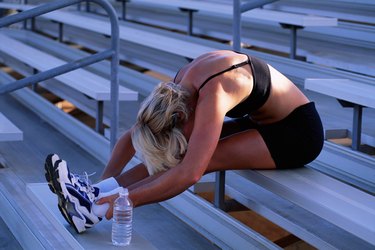
Chronic venous insufficiency exercise recommendations focus on improving circulatory health and preventing complications. This condition tends to get worse over time, but it can be managed through lifestyle changes. A low-sodium diet combined with regular exercise may help.
What Is Chronic Venous Insufficiency?
Video of the Day
A sedentary lifestyle, smoking, mindless eating and prolonged sitting may affect circulation. In the long run, you may develop chronic venous insufficiency, a condition that impairs blood circulation in the leg veins. Also known as venous reflux, this disorder occurs when the blood pressure inside your leg veins is higher than normal for long periods, explains the University of California San Francisco.
Video of the Day
Chronic venous insufficiency appears to be more common in women over 50, people who have overweight and those who smoke or get little or no exercise. Pregnant women are at risk too. The primary symptoms include leg pain and heaviness, varicose veins, and swelling of the lower legs and ankles, especially after prolonged standing. If you have this condition, the skin on your legs may become flaky, itchy or bluish.
Around 40 percent of U.S. adults have venous reflux, reports the Cleveland Clinic. The risk is higher among women. Without adequate treatment, this condition may lead to burst capillaries, which may put you at risk of venous leg ulcers that can then become infected.
According to the U.S. National Library of Medicine, early treatment may help prevent complications and improve your symptoms. Unfortunately, this condition is often under-diagnosed and under-treated, states a research paper published in Maedica in January 2017. Depending on its severity, lifestyle changes may be enough, or you may require medication and more invasive treatments.
Chronic Venous Insufficiency Exercise Recommendations
Prolonged sitting is a risk factor for venous deficiency. As the U.S. National Library of Medicine notes, even moving your legs slightly helps increase blood flow, although physical activity is recommended.
Whether or not exercise can help is subject to debate. According to a research paper published in The Cochrane Database of Systematic Reviews in December 2016, there isn't enough evidence to confirm the efficacy of physical exercise in the management of this condition. Maedica, on the other hand, states that walking and exercising the calf muscles is an integral part of treatment. Using compression stockings may help improve your symptoms too.
Read more: Top 5 Calf Exercises Without Weights
Chronic venous insufficiency exercise recommendations depend largely on the severity of your condition. Generally, it's advisable to do exercises that help you maintain a healthy weight and improve blood flow to your legs.
The University of Michigan, for example, recommends 30 to 60 minutes of steady-state cardio, 10 to 20 minutes of weight training and up to five minutes of light stretching each day. Like with any other exercise, it's important to warm up before getting started and cool down when you're done training.
Try Aerobic Exercises
Engage in aerobic exercise most days of the week, advises the University of Michigan. Your workout should be intense enough to raise your heart rate but you should still be able to hold a conversation. If you find it difficult to exercise for 30 to 60 minutes, split your training routine into mini workouts.
Stretching, walking and weight lifting are just as important as aerobic training. Walking improves circulation, aids in weight management and keeps your bones and muscles strong, according to the Arthritis Foundation.
Read more: 20 Reasons to Go for a Walk Right Now
Calf exercises may help too, suggests a small study published in Phlebology: The Journal of Venous Disease in May 2018. Subjects who did isokinetic exercises for the calf muscles three days a week for three months experienced improvements in muscle strength, mobility and quality of life.
Isokinetic exercises are typically performed with the use of special machines that can be found in rehab centers, so you may want to ask your physiotherapist about it. In the meantime, you may improve blood flow to your legs and strengthen your calf muscles with simple at-home exercises, a stationary bike or an elliptical trainer.
With a few exceptions, most exercises are safe for those with venous insufficiency. The University of Michigan states that isometric movements, such as planks and triceps extensions against a wall, should be avoided. Stop any activity if you experience chest pain, lightheadedness or difficulty breathing. To stay on the safe side, consult your doctor before starting an exercise program.
Read more: 3 Exercises to Build Bigger, Stronger Calves at Home
- University of California San Francisco: "Chronic Venous Insufficiency"
- Cleveland Clinic: "Chronic Venous Insufficiency (CVI)"
- U.S. National Library of Medicine: "Venous Insufficiency"
- Maedica: "Chronic Venous Insufficiency: a Frequently Underdiagnosed and Undertreated Pathology"
- The Cochrane Database of Systematic Reviews: "Physical Exercise for the Treatment of Non‐Ulcerated Chronic Venous Insufficiency"
- University of Michigan: "Exercise Instructions - Chronic Venous Insufficiency"
- Arthritis Foundation: "12 Benefits of Walking"
- Phlebology: The Journal of Venous Disease: "Effects of Isokinetic Calf Muscle Exercise Program on Muscle Strength and Venous Function in Patients With Chronic Venous Insufficiency"
Is this an emergency? If you are experiencing serious medical symptoms, please see the National Library of Medicine’s list of signs you need emergency medical attention or call 911.